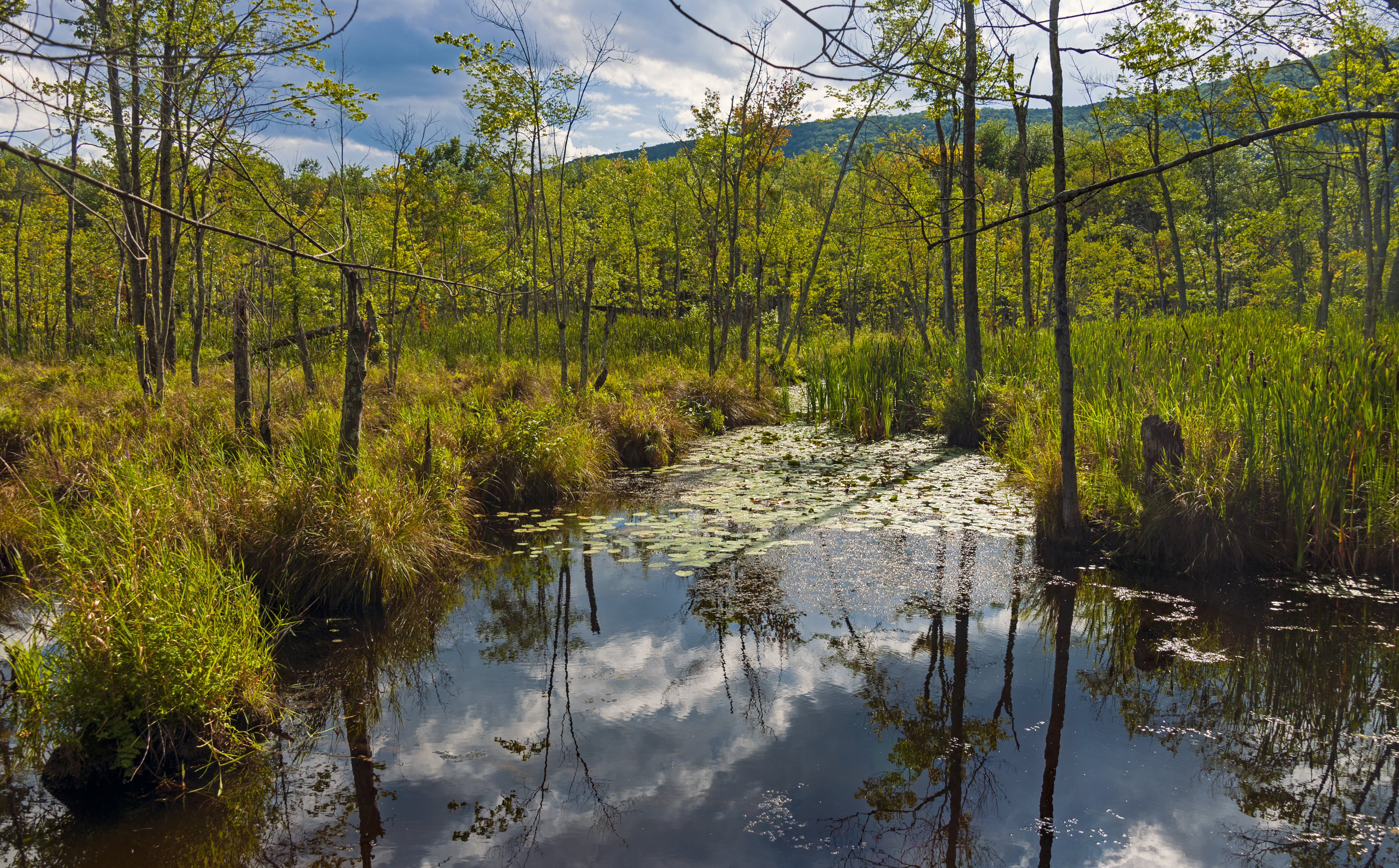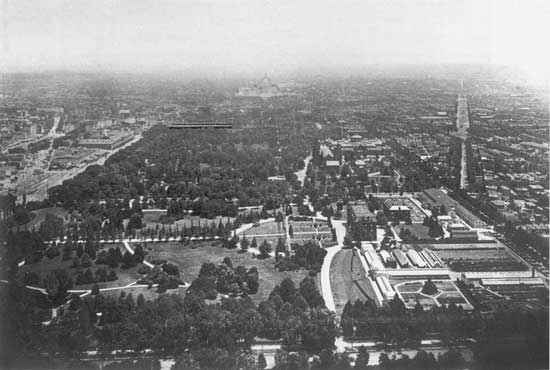|
Dutchess Company Superintendent's House
The Dutchess Company Superintendent's House is a home located on Market Street in the western corner of the village of Wappingers Falls, New York, United States. It is a large brick residence that was built as housing for the manager of the Dutchess Company, a large local printing works, shortly after the plant was built in 1848. It is primarily in the Greek Revival architectural style, with some Gothic Revival decorative touches. In 1984 it was added to the National Register of Historic Places. Building The house is a three-story, five- bay brick building with a symmetrical front facade. The front entrance and its sidelights are centrally located on a shed-roofed porch built in the mid 20th-century. It replaced an original veranda that wrapped around all but the east side. A portion was left on the north side, along with its Gothic Revival posts, capitals and other trim. On the roofline, a steeply pitched central gable, decorated with Gothic Revival vergeboard, reinforces ... [...More Info...] [...Related Items...] OR: [Wikipedia] [Google] [Baidu] |
Wappingers Falls, New York
Wappingers Falls is a village in Dutchess County, New York, United States. As of the 2010 census it had a population of 5,522. The community was named for the cascade in Wappinger Creek. The Wappingers Falls post office covers areas in the towns of Wappinger, Poughkeepsie, Fishkill, East Fishkill, and LaGrange. This can result in some confusion when residents of the outlying towns, who do not live in the village, give their address as "Wappingers Falls". Wappingers Falls' Grinnell Library is the sixth-oldest library in the state. History The Wappinger were an Algonquian-speaking confederacy of Native Americans whose territory in the 17th century extended along the eastern bank of the Hudson River. Primarily based in what is now Dutchess County, their territory was bordered by Manhattan Island to the south, the Mahican territory bounded by the Roeliff Jansen Kill to the north, and extended east into parts of Connecticut. ''Wappinger'' means "easterner" in most Algonquian l ... [...More Info...] [...Related Items...] OR: [Wikipedia] [Google] [Baidu] |
Gable
A gable is the generally triangular portion of a wall between the edges of intersecting roof pitches. The shape of the gable and how it is detailed depends on the structural system used, which reflects climate, material availability, and aesthetic concerns. The term gable wall or gable end more commonly refers to the entire wall, including the gable and the wall below it. Some types of roof do not have a gable (for example hip roofs do not). One common type of roof with gables, the gable roof, is named after its prominent gables. A parapet made of a series of curves (Dutch gable) or horizontal steps (crow-stepped gable) may hide the diagonal lines of the roof. Gable ends of more recent buildings are often treated in the same way as the Classic pediment form. But unlike Classical structures, which operate through trabeation, the gable ends of many buildings are actually bearing-wall structures. Gable style is also used in the design of fabric structures, with varying degree ... [...More Info...] [...Related Items...] OR: [Wikipedia] [Google] [Baidu] |
National Register Of Historic Places In Dutchess County, New York
List of the National Register of Historic Places listings in Dutchess County, New York This is intended to be a complete list of the 128 properties and districts listed on the National Register of Historic Places in Dutchess County, New York outside of Poughkeepsie and Rhinebeck. The locations of National Register properties and districts (at least for all showing latitude and longitude coordinates below) may be seen in a map by clicking on "Map of all coordinates". There are eight properties and districts which are further designated National Historic Landmarks in the county. Locations in the city and town of Poughkeepsie are listed separately, as are the locations in the town and village of Rhinebeck. Current listings Poughkeepsie Rhinebeck Remainder of county See also * National Register of Historic Places listings in New York Ref ... [...More Info...] [...Related Items...] OR: [Wikipedia] [Google] [Baidu] |
Houses Completed In 1848
A house is a single-unit residential building. It may range in complexity from a rudimentary hut to a complex structure of wood, masonry, concrete or other material, outfitted with plumbing, electrical, and heating, ventilation, and air conditioning systems.Schoenauer, Norbert (2000). ''6,000 Years of Housing'' (rev. ed.) (New York: W.W. Norton & Company). Houses use a range of different roofing systems to keep precipitation such as rain from getting into the dwelling space. Houses may have doors or locks to secure the dwelling space and protect its inhabitants and contents from burglars or other trespassers. Most conventional modern houses in Western cultures will contain one or more bedrooms and bathrooms, a kitchen or cooking area, and a living room. A house may have a separate dining room, or the eating area may be integrated into another room. Some large houses in North America have a recreation room. In traditional agriculture-oriented societies, domestic animals such as ... [...More Info...] [...Related Items...] OR: [Wikipedia] [Google] [Baidu] |
Greek Revival Houses In New York (state)
Greek may refer to: Greece Anything of, from, or related to Greece, a country in Southern Europe: *Greeks, an ethnic group. *Greek language, a branch of the Indo-European language family. **Proto-Greek language, the assumed last common ancestor of all known varieties of Greek. **Mycenaean Greek, most ancient attested form of the language (16th to 11th centuries BC). **Ancient Greek, forms of the language used c. 1000–330 BC. **Koine Greek, common form of Greek spoken and written during Classical antiquity. **Medieval Greek or Byzantine Language, language used between the Middle Ages and the Ottoman conquest of Constantinople. **Modern Greek, varieties spoken in the modern era (from 1453 AD). *Greek alphabet, script used to write the Greek language. *Greek Orthodox Church, several Churches of the Eastern Orthodox Church. *Ancient Greece, the ancient civilization before the end of Antiquity. * Old Greek, the language as spoken from Late Antiquity to around 1500 AD. Other uses * ' ... [...More Info...] [...Related Items...] OR: [Wikipedia] [Google] [Baidu] |
Houses On The National Register Of Historic Places In New York (state)
A house is a single-unit residential building. It may range in complexity from a rudimentary hut to a complex structure of wood, masonry, concrete or other material, outfitted with plumbing, electrical, and heating, ventilation, and air conditioning systems.Schoenauer, Norbert (2000). ''6,000 Years of Housing'' (rev. ed.) (New York: W.W. Norton & Company). Houses use a range of different roofing systems to keep precipitation such as rain from getting into the dwelling space. Houses may have doors or locks to secure the dwelling space and protect its inhabitants and contents from burglars or other trespassers. Most conventional modern houses in Western cultures will contain one or more bedrooms and bathrooms, a kitchen or cooking area, and a living room. A house may have a separate dining room, or the eating area may be integrated into another room. Some large houses in North America have a recreation room. In traditional agriculture-oriented societies, domestic animals s ... [...More Info...] [...Related Items...] OR: [Wikipedia] [Google] [Baidu] |
Wappinger Creek
Wappinger Creek is a U.S. Geological Survey. National Hydrography Dataset high-resolution flowline dataThe National Map, accessed October 3, 2011 creek which runs from Thompson Pond to the Hudson River at New Hamburg in Dutchess County, New York, United States. It is the longest creek in Dutchess County, with the largest watershed in the county. Overview The creek flows in a north–south direction on the eastern side of the Hudson River. The creek's source is Thompson Pond near Pine Plains, and it heads southwestward towards its mouth in the Hudson River near New Hamburg. Along the way, it goes through fluctuations in width and follows an erratic path. The initial of the creek runs through rocky, steep, wooded terrain. However, as it approaches the Hudson it enters the river's tidal range, and has sandbars, mudflats and marshes. The creek is also home to numerous species, and is an important spawning area for anadromous fish, which thrive in the creek between April ... [...More Info...] [...Related Items...] OR: [Wikipedia] [Google] [Baidu] |
Newburgh (city), New York
Newburgh is a city in the U.S. state of New York, within Orange County. With a population of 28,856 as of the 2020 census, it is a principal city of the Poughkeepsie–Newburgh–Middletown metropolitan area. Located north of New York City, and south of Albany on the Hudson River within the Hudson Valley Area, the city of Newburgh is located near Stewart International Airport, one of the primary airports for Downstate New York. The Newburgh area was first settled in the early 18th century by the Germans and British. During the American Revolution, Newburgh served as the headquarters of the Continental Army. Prior to its chartering in 1865, the city of Newburgh was part of the town of Newburgh; the town now borders the city to the north and west. East of the city is the Hudson River; the city of Beacon is across the river and it is connected to Newburgh via the Newburgh–Beacon Bridge. The entire southern boundary of the city is with the town of New Windsor. Most of ... [...More Info...] [...Related Items...] OR: [Wikipedia] [Google] [Baidu] |
Andrew Jackson Downing
Andrew Jackson Downing (October 31, 1815 – July 28, 1852) was an American landscape designer, horticulturist, and writer, a prominent advocate of the Gothic Revival in the United States, and editor of ''The Horticulturist'' magazine (1846–52). Downing is considered to be a founder of American landscape architecture. Early life Downing was born in Newburgh, New York, to Samuel Downing, a wheelwright and later nurseryman, and Eunice Bridge. After finishing his schooling at sixteen, he worked in his father's nursery in the Town of Newburgh, and gradually became interested in landscape gardening and architecture. He began writing on botany and landscape gardening and then undertook to educate himself thoroughly in these subjects. He married Caroline DeWint, daughter of John Peter DeWint, in 1838. Professional career His official writing career started when he began producing articles for various newspapers and horticultural journals in the 1830s. In 1841 his first book, ... [...More Info...] [...Related Items...] OR: [Wikipedia] [Google] [Baidu] |
Picturesque
Picturesque is an aesthetic ideal introduced into English cultural debate in 1782 by William Gilpin in ''Observations on the River Wye, and Several Parts of South Wales, etc. Relative Chiefly to Picturesque Beauty; made in the Summer of the Year 1770'', a practical book which instructed England's leisured travellers to examine "the face of a country by the rules of picturesque beauty". Picturesque, along with the aesthetic and cultural strands of Gothic and Celticism, was a part of the emerging Romantic sensibility of the 18th century. The term "picturesque" needs to be understood in relationship to two other aesthetic ideals: the ''beautiful'' and the ''sublime''. By the last third of the 18th century, Enlightenment and rationalist ideas about aesthetics were being challenged by looking at the experiences of beauty and sublimity as non-rational. Aesthetic experience was not just a rational decision – one did not look at a pleasing curved form and decide it was beauti ... [...More Info...] [...Related Items...] OR: [Wikipedia] [Google] [Baidu] |
Scroll Saw
A scroll saw is a small electric or pedal-operated saw used to cut intricate curves in wood, metal, or other materials. The fineness of its blade allows it to cut more delicately than a power jigsaw, and more easily than a hand coping saw or fretsaw. Like those tools, it is capable of creating curves with edges, by pivoting its table. The scroll saw's name derives from its traditional use in making scrollwork, sculptural ornaments which prominently featured scroll-head designs. Advantages While somewhat similar to a band saw, a scroll saw uses a reciprocating blade rather than a continuous loop. Like a hand coping saw, the scroll saw's blade can be removed and placed through a pre-drilled starting hole, allowing interior cutouts to be made without an entry slot. Also, the fineness in both width and tooth count of a scroll's blade permits significantly more intricate curves than even the narrowest gauge band-saw blade. The majority of scroll saws offer a small light on a flex ... [...More Info...] [...Related Items...] OR: [Wikipedia] [Google] [Baidu] |
Wappingers Falls Historic District
The Wappingers Falls Historic District is in the center of that village in Dutchess County, New York, United States. It is a 90-acre (36 ha) area roughly centered along South Avenue and West Main Street, NY 9D and Wappinger Creek. It includes Mesier Park in the center of the village and many adjacent residential neighborhoods, roughly bounded by Elm, Park, Walker, Market and McKinley streets. Much of the district was built in the wake of the industrialization of Wappingers Falls in the 19th century, and its styles represent a cross-section of that century. However, the contributing properties include older buildings, like the ca. 1740 Mesier-Brewer House, and newer ones like the Village Hall, formerly a post office designed under the supervision of Franklin D. Roosevelt during his presidency. History In 1819 a small cotton mill was built in the hollow created by the creek as it descends from Lake Wappinger to drain into the nearby Hudson River. By 1856 it had become one of ... [...More Info...] [...Related Items...] OR: [Wikipedia] [Google] [Baidu] |







